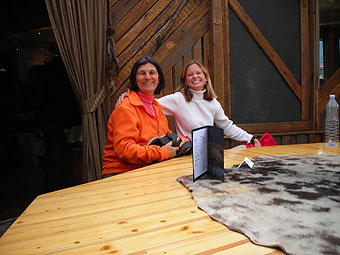

 | |||||||||
|
|
Journals 2007/2008Megan O'Neill
July 28, 2007 I awoke with renewed strength and energy with the knowledge that I would be meeting the Spanish scientists today. Our meeting was at 10am, but I was not sure if we were to meet at the hotel or at the boat. I had noticed that the boat had arrived at port the day before and was anxious to see this massive vessel! Fortunately at breakfast, I was speaking with some scientists from Belgium, Germany and Colorado and one of the Spaniards overheard me speaking of the ship and introduced himself, Roger, and Ben. I was so relieved to find out that we were meeting in the hotel. My conversation over breakfast was fascinating because the scientist from Hamburg, Germany was a geologist that had been to Svalbard many times beginning in 1972. I was so curious to find out more about his experiences and heard many tales of being out in the field studying and seeing polar bears! This place seemed like the mecca for scientists. They were collecting geological samples to study for oil and gas resources all over. At last! Meeting the others! I was thrilled to finally meet Angelo, the lead scientist, and the other teacher from Spain, Catalina Sureda. I was especially interested to meet her, as she had written me a letter after not being able to contact me via e-mail. She had mentioned that she was a high school teacher of biology and geology for thirty years. I was excited to gain some of her teaching knowledge and coordinate some projects. Angelo described our project, SVAIS, in which we are studying geology of the continental margin off the coast of Svalbard in the Fram Strait and how glaciers affected it approximately 10,000 years ago when they slid across it. Angelo also introduced us, schedules, jobs and safety precautions on the ship most importantly. After the meeting, we had free time until 7am the next morning to depart for the ship. A group of us went in search of a tour for the afternoon and got lunch. Finally we located a taxi driver that would drive us around the area and describe it to us. Not only were the views spectacular that he showed us, but I got to take pictures of something that has been mentioned in our textbooks - the World Seed Bank. This is a project to be completed in September in which a hole is dug into the earth in the permafrost. In this structure, all the seeds of all the species of plants will be stored for eternity in case of any tragedy that strikes the planet. This reserve will provide a back up for any seeds lost to nuclear war, genetic testing, etc. How exciting! I actually have pictures of this place! We also passed by a dog sled farm where the dogs were fed seals. The owners hung the seals in the air on a tripod to keep the polar bears from stealing them. After the tour, we went to the grocery store. It was interesting to see how expensive the fruits and vegetables were (almost ten dollars for orange bell peppers and 7 for frozen blueberries when they are only 3 per quart and fresh at home this time of year). Thinking about how far they must ship these things and how much effort goes into getting them to this part of the world was mind boggling.
|
||||||||
